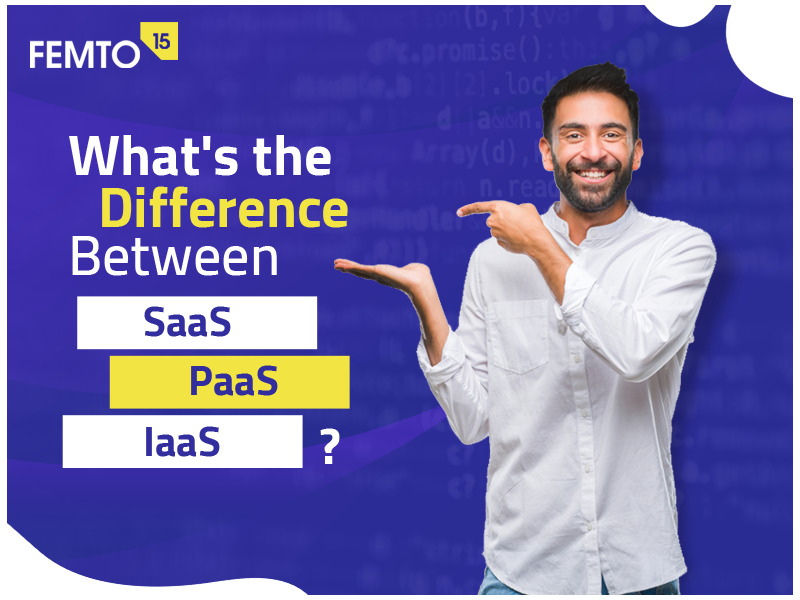
What’s the Difference Between SaaS, PaaS, and IaaS?
By Femto15 Team - January 24, 2020The cloud industry has changed how things work in the tech field. Currently, there is a cloud service in each organization in a way or another. Whether you are the service provider or the user, you have a relationship with a cloud service.
That's why you need to understand cloud computing models and distinguish between them to be confident when choosing the model that works best for your business.
First, we need to define the concept of "Cloud Computing". Then, we will illustrate each model separately. Finally, we will compare those models.
What is cloud computing? (as a Service)
Cloud computing is the delivery of computing services—including servers, storage, databases, networking, software, analytics, and intelligence—over the Internet (“the cloud”) to offer faster innovation, flexible resources, and economies of scale. You typically pay only for cloud services you use, helping you lower your operating costs, run your infrastructure more efficiently, and scale as your business needs change.
Microsoft Azure
The concept of cloud computing represents the common factor of the three shortcuts; which is "aaS" that stands for "as a Service". That's the idea of paying for what you need as long as you need it and for the specific service you need.
The advantage of cloud models:
- Flexibility
- Scalability
- Cost-effective
- Easily accessible through the internet
- Fast
The other parts of the three shortcuts are Software, Platform, and Infrastructure.
Software, Platform, and Infrastructure
Let's imagine that you want to build a hospital. What would you need?
- The land or location where you would build the hospital.
- The equipment and material you would build with.
After the hospital is built, patients can visit it and pay for the service they get there.
Software applications are just like that, you need hardware to store your data, application, OS, etc. into, you need tools to develop your app, and once the app is complete, you can provide it for users.
IaaS, PaaS, and SaaS are those three levels in the
SaaS
Software as a service means any software that is available through the cloud. All you need is an internet connection and, in most cases, only a web browser and you can get the service from SaaS provider and pay as you go.
Service providers manage all software details; from hosting to maintenance, which frees most organizations from the tech headache and saves them money and time.
On the other hand, SaaS may have some concerns related to data security and control. You may be locked, as SaaS providers may give you a hard time when you want to transfer your business. There is also the problem of customization as one way of providing the service may not fit all users.
Examples of SaaS are Google Docs, Dropbox, and Slack.
PaaS
PaaS is an environment that provides everything developers may need to develop and deploy their applications. The service enables you to use all software tools and resources needed to create your app without the pain of installing programs and the high costs of local development tools and platforms.
PaaS providers manage all IaaS layers along with things like middleware systems. You only care about developing and managing your app while PaaS providers handle the rest.
Examples of PaaS are Google App Engine and Heroku.
IaaS
IaaS service provides computing resources themselves. The provider allows customers to access virtual machines, such as servers, over the cloud. You control these virtual machines just like any hardware but without having it locally.
The provider handles the infrastructure, while the administrator manages other things related to their software, which means more things and layers to manage and more control over your system.
Examples of IaaS are Google Compute Engine and Microsoft Azure.
What's the differe nce?
Let's wrap things up:
- IaaS: machines that host your data or system.
- PaaS: tools that are used to build software apps.
- SaaS: the application itself.
You can compare the three models from two aspects:
The user of each model
The client of each model differs according to each model's usage and requirements.

Management and control
With great power comes great responsibility
Uncle Ben, Spider man
That rule works on the software world too. Whichever the model you choose for your business, you need to understand your limits and your responsibilit
Here is a common comparison that shows what you and your provider mange in each model.

Final words
The cloud is the future. So whichever the function you need, you can find a cloud service that provides it. Just define your needs and resources to enter the cloud era.
ABOUT AUTHOR
Femto15 Team


you may also like
0 comments